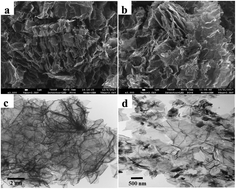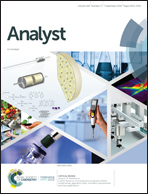The efficient profiling of serum N-linked glycans by a highly porous 3D graphene composite†
Abstract
In this work, an enrichment approach for the profiling of N-linked glycans was developed by utilizing a highly porous 3D graphene composite fabricated from graphene oxide nanosheets and a phenol-formaldehyde polymer via graphitization and KOH activation. In tailoring the large surface area (ca. 2213 m2 g−1) and 3D-layered mesoporous structure, the 3D graphene composite demonstrated not only high efficiency in glycan enrichment but also the size-exclusion effect against residual protein interference. For a standard protein ovalbumin digest, 26 N-linked glycans were identified with good repeatability, and the detection limit was as low as 0.25 ng μL−1 with the identification of 13 N-linked glycans (S/N > 10). When the mass ratio of the ovalbumin digest to the interfering proteins, i.e., bovine serum albumin and ovalbumin was 1 : 2000 : 2000, 18 N-linked glycans could still be detected with sufficient signal intensities. From a 60 nL minute complex human serum sample, up to 53 N-linked glycans with S/N > 10 were identified after the 3D graphene enrichment, while only 20 N-linked glycans were identified by the porous graphitized carbon material used for comparison. In addition, the application of the 3D graphene composite in profiling the up-regulated and down-regulated N-linked glycans from the real clinical serum samples of ovarian cancer patients confirmed the potential of the 3D graphene composite for analyzing minute and complicated biological samples.



 Please wait while we load your content...
Please wait while we load your content...